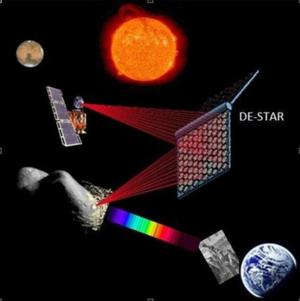Planetary securitySystem to vaporize asteroids that threaten Earth
As an asteroid roughly half as large as a football field — and with energy equal to a large hydrogen bomb – flew by Earth on Friday, two California scientists unveiled their proposal for a system that could eliminate a threat of this size in an hour. The same system could destroy asteroids ten times larger than the one known as 2012 DA14 in about a year, with evaporation starting at a distance as far away as the Sun.

Schematic rendering of the DE-STAR concept // Source: hinews.cn
As an asteroid roughly half as large as a football field — and with energy equal to a large hydrogen bomb – flew by Earth on Friday, two California scientists unveiled their proposal for a system that could eliminate a threat of this size in an hour. The same system could destroy asteroids ten times larger than the one known as 2012 DA14 in about a year, with evaporation starting at a distance as far away as the Sun.
A University of California, Santa Barbara release reports that UC Santa Barbara physicist and professor Philip M. Lubin, and Gary B. Hughes, a researcher and professor from California Polytechnic State University, San Luis Obispo, conceived DE-STAR, or Directed Energy Solar Targeting of Asteroids an exploRation, as a realistic means of mitigating potential threats posed to the Earth by asteroids and comets.
“We have to come to grips with discussing these issues in a logical and rational way,” said Lubin, who began work on DE-STAR a year ago. “We need to be proactive rather than reactive in dealing with threats. Duck and cover is not an option. We can actually do something about it and it’s credible to do something. So let’s begin along this path. Let’s start small and work our way up. There is no need to break the bank to start.”
Described as a “directed energy orbital defense system,” DE-STAR is designed to harness some of the power of the sun and convert it into a massive phased array of laser beams that can destroy, or evaporate, asteroids posing a potential threat to Earth. It is equally capable of changing an asteroid’s orbit — deflecting it away from Earth, or into the Sun — and may also prove to be a valuable tool for assessing an asteroid’s composition, enabling lucrative, rare-element mining. It is entirely based on current essential technology.
“This system is not some far-out idea from Star Trek,” Hughes said. “All the components of this system pretty much exist today. Maybe not quite at the scale that we’d need — scaling up would be the challenge — but the basic elements are all there and ready to go. We just need to put them into a larger system to be effective, and once the system is there, it can do so many things.”
The same system has a number of other uses, including aiding in planetary exploration.
In developing the proposal, Lubin
